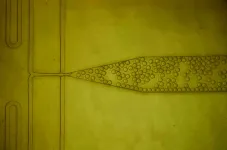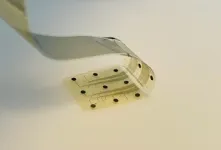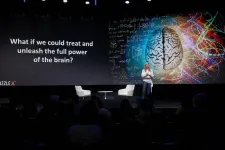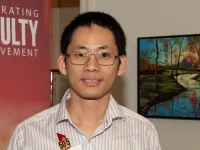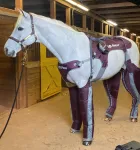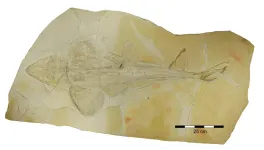(Press-News.org) CAMBRIDGE, MA -- One of the most expensive steps in manufacturing protein drugs such as antibodies or insulin is the purification step: isolating the protein from the bioreactor used to produce it. This step can account for up to half of the total cost of manufacturing a protein.
In an effort to help reduce those costs, MIT engineers have devised a new way to perform this kind of purification. Their approach, which uses specialized nanoparticles to rapidly crystallize proteins, could help to make protein drugs more affordable and accessible, especially in developing countries.
“This work uses bioconjugate-functionalized nanoparticles to act as templates for enhancing protein crystal formation at low concentrations,” says Kripa Varanasi, a professor of mechanical engineering at MIT and the senior author of the new study. “The goal is to reduce the cost so that this kind of drug manufacturing becomes affordable in the developing world.”
The researchers demonstrated that their approach can be used to crystallize lysozyme (an antimicrobial enzyme) and insulin. They believe it could also be applied to many other useful proteins, including antibody drugs and vaccines.
MIT graduate student Caroline McCue is the lead author of the study, which appears today in the journal ACS Applied Materials and Interfaces. Henri-Louis Girard PhD ’20 is also an author of the paper.
Protein purification
Antibodies and other protein drugs are part of a growing class of drugs known as biologics, which also include molecules such as DNA and RNA, as well as cell-based therapies. Most protein drugs are produced by living cells such as yeast in large bioreactors.
Once these proteins are generated, they have to be isolated from the reactor, which is usually done through a process called chromatography. Chromatography, which separates proteins based on their size, requires specialized materials that make the process very expensive.
Varanasi and his colleagues decided to try a different approach, based on protein crystallization. Researchers often crystallize proteins to study their structures, but the process is considered too slow for industrial use and doesn’t work well at low concentrations of protein. To overcome those obstacles, Varanasi’s lab set out to use nanoscale structures to speed up the crystallization.
In previous work, the lab has used nanoscale features to create materials that repel water or to modify interfaces for injecting highly viscous biologic drugs. In this case, the researchers wanted to adapt nanoparticles so that they could locally increase the concentration of protein at the surface and also provide a template that would allow the proteins to align correctly and form crystals.
To create the surface they needed, the researchers coated gold nanoparticles with molecules called bioconjugates — materials that can help form links between other molecules. For this study, the researchers used bioconjugates called maleimide and NHS, which are commonly used for tagging proteins for study or attaching protein drugs to drug-delivering nanoparticles.
When solutions of proteins are exposed to these coated nanoparticles, the proteins accumulate at the surface and bind to the bioconjugates. Furthermore, the bioconjugates compel the proteins to align themselves with a specific orientation, creating a scaffold for additional proteins to come along and join the crystal.
The researchers demonstrated their approach with lysozyme, an enzyme whose crystallization properties have been well studied, and insulin. They say it could also be applied to many other proteins.
“This is a general approach that could be scaled to other systems as well. If you know the protein structure that you’re trying to crystallize, you can then add the right bioconjugates that will force this process to happen,” Varanasi says.
Rapid crystallization
In their studies with lysozyme and insulin, the researchers found that crystallization occurred much faster when the proteins were exposed to the bioconjugate-coated nanoparticles, compared to bare nanoparticles or no nanoparticles. With the coated particles, the researchers saw a sevenfold reduction in the induction time — how long it takes for crystals to begin forming — and a threefold increase in the nucleation rate, which is how quickly the crystals grow once started.
“Even at low protein concentrations, we see a lot more crystals forming with these bioconjugate-functionalized nanoparticles,” McCue says. “The functionalized nanoparticles reduce the induction time so much because these bioconjugates are providing a specific site for the proteins to bind. And because the proteins are aligned, they can form a crystal faster.”
In addition, the team used machine learning to analyze thousands of images of crystals. “Protein crystallization is a stochastic process, so we needed to have a huge dataset to be able to really measure whether our approach was improving the induction time and nucleation rate of crystallization. With so many images to process, machine learning is the best way to be able to determine when crystals are forming in each image without having to go through and manually count each one,” McCue says.
This project is part of a Bill and Melinda Gates Foundation effort to make biologic drugs, such as prophylactic antibodies that have been shown to prevent malaria in clinical trials, more widely available in developing nationsThe MIT team is now working on scaling up the process so that it could be used in an industrial bioreactor, and demonstrating that it can work with monoclonal antibodies, vaccines, and other useful proteins.
“If we can make it easier to manufacture these proteins anywhere, then everyone in the world can benefit,” Varanasi says. “We are not saying that this is going to be solved tomorrow because of us, but this is a small step that can contribute to that mission.”
###
In addition to the Gates Foundation, the research was partly funded by a National Science Foundation Graduate Research Fellowship.
END
New purification method could make protein drugs cheaper
MIT engineers find specialized nanoparticles can quickly and inexpensively isolate proteins from a bioreactor.
2023-02-28
ELSE PRESS RELEASES FROM THIS DATE:
Graphene Flagship spin-off company INBRAIN Neuroelectronics wins prestigious innovation award
2023-02-28
INBRAIN Neuroelectronics, a Graphene Flagship spin-off company, has been named Spain’s most innovative company by leading Spanish news publication El Periódico.
INBRAIN exists to decode and modulate neural networks to improve patients’ lives. More specifically, INBRAIN is harnessing the unique properties of graphene to develop high density and high-resolution brain interfaces coupled to an intelligent system with high signal processing power to provide breakthrough neuroelectronic therapies.
The company was founded in 2020 by researchers from Graphene Flagship partner the Catalan Institute of Nanoscience ...
Henry Ford Medical Group appoints Dr. Brien J. Smith to top neurology role
2023-02-28
DETROIT (February 28, 2023) – The Henry Ford Medical Group today announced Brien J. Smith, M.D., MBA, a national expert in neurology and epilepsy, as its new Chair of the Department of Neurology.
In this leadership role, Dr. Smith will oversee all clinical, research and administrative services for the Department of Neurology at Henry Ford Health. A veteran of Henry Ford, Dr. Smith was previously part of Henry Ford Hospital’s Neurology Department for 18 years, serving as Director of the Epilepsy Monitoring Unit, Medical Director of the Comprehensive Epilepsy Program, and Director of the Clinical Neurophysiology Program at Henry Ford Hospital in Detroit. He ...
Responsive ankle exoskeleton algorithm handles changes in pace and gait
2023-02-28
Images
Ankle exoskeletons that can help people extend their endurance are a step closer to reality with a new control algorithm, developed at the University of Michigan, that could enable future exoskeletons to automatically adapt to individual users and tasks. This would reduce or eliminate the need for manual recalibration.
Current exoskeletons are limited because they must be tailored to a single user performing a single task, like walking in a straight line. Any changes require a lengthy set ...
Obesity makes it harder to diagnose and treat heart disease
2023-02-28
ROCHESTER, Minn. — Being overweight impacts your heart health in more ways than you might think. A new JACC review paper from Mayo Clinic outlines how obesity affects the common tests used to diagnose heart disease and impacts treatments. Cardiovascular disease is the leading cause of death in the U.S. and globally, yet it is largely preventable.
"Excess fat acts as a kind of filter and can skew test readings to under-or overdiagnosis," says senior author Francisco Lopez-Jimenez, M.D., director of preventive cardiology at Mayo Clinic. "Obesity affects ...
Shirley Ryan AbilityLab receives department of defense grant for first-of-its-kind study on neurally controlled bionic legs with osseointegration
2023-02-28
CHICAGO — Feb. 28, 2023 — Today, millions of individuals across the world live with limb loss, including thousands of combat-injured service men and women. Although significant progress has been made in the durability, control and function of prosthetic devices, they lack complete integration into the body.
Now, with the award of a $1.5 million grant from the Department of Defense Congressionally Directed Medical Research Program (CDMRP), Shirley Ryan AbilityLab — the top-ranked physical medicine and rehabilitation hospital — ...
BU researchers receive $1.3m EPA grant to advance climate resilience among Mystic River communities
2023-02-28
FOR IMMEDIATE RELEASE
February 28, 2023
Contact:
Jillian McKoy, jpmckoy@bu.edu
Michael Saunders, msaunder@bu.edu
##
BU Researchers Receive $1.3M EPA Grant to Advance Climate Resilience among Mystic River Communities
The three-year project aims to identify and address the cumulative impacts of chemical hazards and climate change that affect the 21 communities surrounding the Mystic River Watershed.
The 21 communities that surround Greater Boston’s Mystic River Watershed are exposed to many of the central threats of climate change, including urban heat islands and coastal and inland flooding, while also confronting multiple chemical exposures.
Now, with ...
Artificial intelligence with a human touch
2023-02-28
Despite the remarkable progress in artificial intelligence (AI), several studies show that AI systems do not improve radiologists' diagnostic performance. In fact, diagnostic errors contribute to 40,000 - 80,000 deaths annually in U.S. hospitals. This lapse creates a pressing need: Build next-generation computer-aided diagnosis algorithms that are more interactive to fully realize the benefits of AI in improving medical diagnosis.
That’s just what Hien Van Nguyen, University of Houston associate professor of electrical and computer engineering, is doing with a new $933,812 grant from the National Cancer Institute. He will focus on ...
Compression treatment could relieve horses’ painful swollen limbs
2023-02-28
Researchers from North Carolina State University have taken technology aimed at helping humans suffering from lymphedema – in which the accumulation of excess lymph fluid causes swollen limbs – and developed a medical device to aid horses suffering from the same condition. In a pilot study the device, called the EQ Press, was successful in moving fluid up the limbs and into the lymph nodes. This could lead to relief for horses with chronic conditions, as well as with temporary swelling due to injury or inactivity.
“Across the board, ...
Jurassic shark – Shark from the Jurassic period was already highly evolved
2023-02-28
Cartilaginous fish have changed much more in the course of their evolutionary history than previously believed. Evidence for this thesis has been provided by new fossils of a ray-like shark, Protospinax annectans, which demonstrate that sharks were already highly evolved in the Late Jurassic. This is the result of a recent study by an international research group led by palaeobiologist Patrick L. Jambura from the Department of Palaeontology at the University of Vienna, which was recently published in the journal Diversity.
Cartilaginous fishes (sharks, rays, and ratfish) ...
Flower power: Research highlights the role of ants in forest regeneration
2023-02-28
BINGHAMTON, N.Y. -- Ants play a key role in forest regeneration, according to a new paper from Binghamton University, State University of New York.
Walk through an old growth forest in early spring, and you’ll be dazzled by wildflowers, their jewel-like tones shining from the forest floor.
But in newer forests, spring ephemerals such as trillium, wild ginger, violets and bloodroot are in shorter supply. The reason may lie with some less-flashy forest residents: Aphaenogaster sp., or the woodland ant.
“Not a lot of people have heard of them, but they are ...
LAST 30 PRESS RELEASES:
Making lighter work of calculating fluid and heat flow
Normalizing blood sugar can halve heart attack risk
Lowering blood sugar cuts heart attack risk in people with prediabetes
Study links genetic variants to risk of blinding eye disease in premature infants
Non-opioid ‘pain sponge’ therapy halts cartilage degeneration and relieves chronic pain
AI can pick up cultural values by mimicking how kids learn
China’s ecological redlines offer fast track to 30 x 30 global conservation goal
Invisible indoor threats: emerging household contaminants and their growing risks to human health
Adding antibody treatment to chemo boosts outcomes for children with rare cancer
Germline pathogenic variants among women without a history of breast cancer
Tanning beds triple melanoma risk, potentially causing broad DNA damage
Unique bond identified as key to viral infection speed
Indoor tanning makes youthful skin much older on a genetic level
Mouse model sheds new light on the causes and potential solutions to human GI problems linked to muscular dystrophy
The Journal of Nuclear Medicine ahead-of-print tip sheet: December 12, 2025
Smarter tools for peering into the microscopic world
Applications open for funding to conduct research in the Kinsey Institute archives
Global measure underestimates the severity of food insecurity
Child survivors of critical illness are missing out on timely follow up care
Risk-based vs annual breast cancer screening / the WISDOM randomized clinical trial
University of Toronto launches Electric Vehicle Innovation Ontario to accelerate advanced EV technologies and build Canada’s innovation advantage
Early relapse predicts poor outcomes in aggressive blood cancer
American College of Lifestyle Medicine applauds two CMS models aligned with lifestyle medicine practice and reimbursement
Clinical trial finds cannabis use not a barrier to quitting nicotine vaping
Supplemental nutrition assistance program policies and food insecurity
Switching immune cells to “night mode” could limit damage after a heart attack, study suggests
URI-based Global RIghts Project report spotlights continued troubling trends in worldwide inhumane treatment
Neutrophils are less aggressive at night, explaining why nighttime heart attacks cause less damage than daytime events
Menopausal hormone therapy may not pose breast cancer risk for women with BRCA mutations
Mobile health tool may improve quality of life for adolescent and young adult breast cancer survivors
[Press-News.org] New purification method could make protein drugs cheaperMIT engineers find specialized nanoparticles can quickly and inexpensively isolate proteins from a bioreactor.
